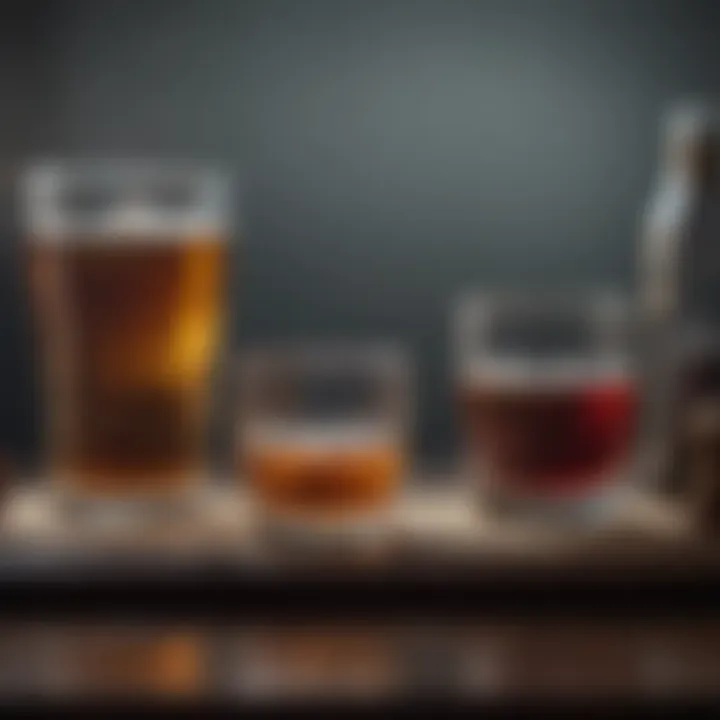Understanding the Alcohol Scale: An In-Depth Examination


Intro
The alcohol scale serves as an essential framework that categorizes alcohol concentration and its effects. Understanding this scale is critical not just for casual consumers but also for researchers, educators, and policymakers who navigate the complex landscape of alcohol regulation and health. This guide examines the multifaceted aspects of the alcohol scale, from its historical origins to its contemporary implications in health and society.
Overview of Research Topic
Brief Background and Context
The concept of measuring alcohol concentration has historical significance. Traditionally, alcoholic beverages have been judged by their perceived strength, often without precise quantification. However, with the rise of scientific inquiry during the 19th century, reliable measurement methods became necessary for both commercial and public health reasons. The alcohol scale, typically gauged in terms of Alcohol by Volume (ABV), plays a crucial role in defining these strengths.
Importance in Current Scientific Landscape
In today’s society, the implications of alcohol consumption are increasingly scrutinized. Studies reveal links between alcohol use and various health outcomes, including addiction, liver disease, and mental health issues. The use of the alcohol scale provides a quantitative basis for understanding these health risks. Therefore, the scale's relevance extends beyond mere numbers; it informs regulatory policies and health recommendations.
Methodology
Research Design and Approach
This examination incorporates a literature review of existing scientific studies, regulatory documents, and public health reports. By synthesizing findings from diverse sources, the analysis aims to clarify how the alcohol scale is implemented and perceived in various contexts.
Data Collection Techniques
Data collection included quantitative measures of alcohol concentration from different beverages, compliance reviews of regulatory frameworks, and qualitative surveys addressing public perception. By merging these methodologies, a comprehensive picture of the alcohol scale and its societal impacts emerges.
"Understanding alcohol measurement is not just about numbers; it is about consequences."
Integrating these dimensions aids in fully grasping the implications of alcohol consumption. It forms the bedrock of further discourse on health impacts and legislative actions regarding alcohol use.
Prelude to the Alcohol Scale
Understanding the alcohol scale is crucial in grasping the complexities of how alcohol is measured and perceived in various contexts. The alcohol scale serves as a foundational tool that influences not only individual choices but also public health policies and industry regulations. This article unfolds the multiple layers of the alcohol scale, emphasizing why comprehending its intricacies can empower consumers, researchers, and policymakers alike.
Defining the Alcohol Scale
The alcohol scale is a systematic approach used to quantify the alcoholic content in beverages. Different scales have been established over time, with the most recognized being the Alcohol by Volume (ABV) and Proof scale. ABV provides a straightforward percentage of alcohol within a drink, giving consumers a clear understanding of how much alcohol they are consuming. Proof, on the other hand, is a different metric primarily used in the United States to express the strength of distilled spirits. It is defined as twice the ABV percentage.
Furthermore, the scale helps in standardizing measurements, making it easier for consumers to compare products. Increasingly, the alcohol scale is not merely a scientific tool but also a social and cultural construct that reflects attitudes towards drinking and regulation.
Importance of Measuring Alcohol Content
Measuring alcohol content is vital for several reasons. First, it ensures consumer safety. Accurate labeling of alcoholic beverages informs consumers about their intake level and potential effects. This is particularly relevant for individuals with health concerns or those who choose to abstain from alcohol. Misleading labels or lack of information can lead to unintended overconsumption.
Moreover, understanding alcohol measurements contributes to public health research. Epidemiologists and health organizations require precise data on alcohol consumption to study its effects on health and to understand trends in drinking behavior across different populations.
Lastly, accurate alcohol measurements are critical for legal compliance. Regulatory bodies impose strict guidelines related to advertising, sales, and consumption. Distillers and beverage manufacturers must comply with these standards to avoid penalties and maintain their licenses.
"The importance of a transparent alcohol scale cannot be understated. It not only protects consumers but also aids in shaping public health initiatives."
By elucidating these elements, one can appreciate the essential role the alcohol scale plays in society, emphasizing the need for ongoing education and awareness regarding alcohol measurements.
Historical Perspectives on Alcohol Measurement
The measurement of alcohol has a rich history that reflects both scientific advancement and cultural practices. Understanding these historical perspectives is crucial to appreciating how different scales originated and evolved over time. This section is not just about the technical aspects; it reveals societal shifts and changing perceptions of alcohol consumption. Historical methods of measurement tell us how societies interacted with alcohol, influencing regulations that still affect us today.
Traditional Methods of Measurement
Before modern science developed rigorous methods to quantify alcohol, early cultures used various traditional systems for measuring alcohol content. The reliance on sensory analysis, such as taste and smell, characterized these early methods. In many cases, local brewers relied on experience and intuition to determine the strength of their beverages.
For instance, in ancient Mesopotamia, different qualities of beer were rated based on their taste and consistency. Alcohol content was less about precision and more about the sensory enjoyment of the drink. Likewise, European societies employed subjective measures long before standardized scales were formed.
Here are some notable traditional methods:


- Visual Inspection: Before scientific measurement, consumers often judged drinks based on opacity and bubbles.
- Taste Tests: Experienced brewers assessed the strength and quality of their products by direct tasting.
- Containers: Some cultures might use the size of containers to hold specific volumes, giving a rough estimation of alcohol content.
These methods, while rudimentary, highlight the significance of alcohol in social contexts, as individual and collective experiences guided the creation and consumption of alcohol long before formal measurements emerged.
Evolution of Alcohol Scales Over Time
As societies progressed, the need for more precise measurements of alcohol became apparent. The evolution of alcohol scales is a reflection of technological advancements and social changes. In the 18th century, the establishment of methods such as distillation allowed for more accurate determinations of alcohol content. This led to the introduction of the proof scale, originally created to protect the interests of distillers and ensure quality control.
The development of the Alcohol by Volume (ABV) metric in the late 19th century marked a significant turning point. ABV allowed for a standardized method of quantifying the actual alcohol content relative to the total volume of liquid, facilitating international trade and communication about alcohol strength.
Some key milestones in the evolution of alcohol measurement include:
- Proof Scale: Introduced in England, initially based on the strength required to ignite gunpowder when mixed with alcohol.
- Alcohol by Volume (ABV): Standardized method that millions of consumers rely on today to understand drink strengths.
- Modern Techniques: Advanced technologies such as gas chromatography and spectrophotometry introduced precise ways of measuring alcohol content.
The transition from traditional to modern methods reflects not only a commitment to scientific rigor but also a response to globalization and public health concerns. Understanding these evolutions informs current practices and aids in developing regulations that balance consumer safety with market needs.
"The history of alcohol measurement is a testament to human ingenuity and evolving understanding of the substances we consume."
Through this historical lens, we gain insight into how alcohol scales became integral to both cultural practices and regulatory frameworks, setting the stage for our modern relationship with alcoholic beverages.
Scientific Foundations of Alcohol Measurement
Understanding the scientific foundations of alcohol measurement is critical for both accurate quantification and meaningful interpretation of alcohol content in various beverages. This section explores the essential aspects of alcohol's chemical composition and the quantitative analysis techniques used in the measurement processes. Accurate measurements are not just vital for health and regulatory reasons; they also play a role in culinary practices, manufacturing, and consumer safety.
Chemical Composition of Alcohol
Alcohol primarily refers to ethanol, a simple molecule with the chemical formula C2OH. It is essential to understand this composition, as variations in its structure can lead to different properties and effects. Ethanol is typically produced through fermentation, where sugars are converted into alcohol by yeast. However, industrial processes may also generate ethanol through synthetic means, such as hydration of ethylene.
In beverages, the concentration of ethanol is significant in determining effects on the human body, as well as the overall flavor profile. By understanding the chemical structure of alcohol, one can better appreciate how it interacts with other compounds in various drinks, influencing taste and potency.
Quantitative Analysis Techniques
Quantitative analysis techniques are critical in determining the exact alcohol concentration in drinks. There are several methods employed in laboratories and production facilities. Not all methods are created equal; each has its unique aspects that contribute to its effectiveness.
Gas Chromatography
Gas chromatography is a powerful analytical method used for separating and analyzing compounds that can be vaporized without decomposition. This technique is beneficial for measuring alcohol content because it allows for the precise identification of mixtures, ensuring accuracy at very low concentrations of ethanol.
A key characteristic of gas chromatography is its high sensitivity, often detecting substances at parts per billion levels. Its ability to analyze complex samples effectively makes it a popular choice in both laboratory research and quality control in the beverage industry. However, the method does require significant calibration and operational expertise, which may limit its application in less specialized settings.
Spectrophotometry
Spectrophotometry measures the amount of light absorbed by a sample at specific wavelengths. This technique can be utilized to determine alcohol concentration based on the principle that alcohol absorbs light differently than other substances in a solution.
The key advantage of spectrophotometry lies in its simplicity and speed. It is often easier and more cost-effective than other methods. However, one limitation is that it may not be as accurate when dealing with mixtures containing multiple compounds because overlapping absorption spectra can obscure the results. Therefore, while useful, it is often paired with other methods for more reliable results.
Hydrometry
Hydrometry employs the use of a hydrometer to measure the specific gravity of a liquid. Specific gravity changes with the concentration of alcohol; therefore, hydrometry can provide an estimate of alcohol content.
The key aspect of hydrometry is its straightforwardness; it can be performed on-site and does not require extensive technical training. However, one unique feature is that temperature can significantly affect specific gravity readings, necessitating corrections to avoid inaccurate interpretations. Additionally, hydrometers are best suited for clearer solutions, making them less effective in the presence of sediments or bubbles that could skew results.
Types of Alcohol Scales
Alcohol scales serve as essential tools for measuring the concentration of alcohol in beverages. Understanding the different types of scales is crucial for anyone engaged in the fields of food science, public health, and regulatory compliance. Each scale offers distinct advantages and is rooted in specific methodologies that cater to various applications. An accurate comprehension of these scales can inform consumers about alcohol content, influence health guidelines, and shape public policy regarding alcohol consumption.
Proof Scale
The proof scale is one of the oldest measures used to quantify alcohol content. Originating in the 18th century, especially popular in the United Kingdom and the United States, the proof system is based on the percentage of alcohol by volume (ABV). The United States defines proof as twice the ABV, meaning a beverage that is 50% ABV would be 100 proof.
This scale serves as a straightforward way to convey potency, helping consumers make informed choices about their drinks.
However, one must note that proof can also lead to misinterpretations. For example, a higher proof does not necessarily correlate with enhanced enjoyment or safety. Additionally, the international community might not universally adopt proof as a metric, which can complicate comparisons of alcoholic beverages across different regions.


Alcohol by Volume (ABV)
Alcohol by Volume, or ABV, represents the percentage of alcohol present in a beverage. The ABV scale provides a more precise understanding of alcohol content than the proof system. It is particularly useful in scientific research and quality control during beverage production.
ABV is calculated by measuring the volume of ethanol in a given volume of liquid, expressed as a percentage. The formula is straightforward:
[ ABV = \left( \fracVolume \ of \ EthanolTotal \ Volume \right) \times 100% ]
Using ABV can give consumers a clear insight into the amount of alcohol they are consuming. Many countries label beverages with their ABV percentage, which has raised awareness about responsible drinking practices. However, one must remain vigilant as ABV labeling does not always capture the complexity of how individuals metabolize alcohol.
Standard Drink Measurement
The standard drink measurement serves as a universal concept to simplify alcohol consumption reporting. This measurement allows for easy comparison among different alcoholic beverages by specifying a standard quantity of pure alcohol. Countries have different definitions, but a standard drink typically contains about 14 grams of pure alcohol.
The idea behind standardizing drink measurements is to facilitate public health messaging and educate individuals about drinking limits. Understanding what constitutes a standard drink is vital in fostering responsible drinking behavior. A few examples include:
- Beer: Approximately 12 ounces of regular beer (5% ABV)
- Wine: About 5 ounces of wine (12% ABV)
- Spirits: Roughly 1.5 ounces of distilled spirits (40% ABV)
Despite its utility, some challenges exist. Definitions may vary across regions which can lead to confusion, especially among international travelers. Nonetheless, the standard drink serves as a valuable reference point in discussions about alcohol consumption's health risks and guidelines.
Health Implications of Alcohol Consumption
Understanding the health implications of alcohol consumption is crucial in the context of both individual and public health. Alcohol affects various body systems and can lead to both immediate and long-lasting consequences. Awareness of these implications helps individuals make more informed decisions regarding their consumption patterns. Additionally, it informs policymakers and health professionals as they develop guidelines and interventions aimed at improving public health outcomes related to alcohol use.
Short-term Effects of Alcohol
The short-term effects of alcohol consumption can be significant. When a person consumes alcohol, it acts as a central nervous system depressant. This can result in lowered inhibitions, impaired judgment, and decreased coordination. Short-term effects may also include feelings of euphoria or relaxation, but these can quickly turn into negative consequences such as nausea, headache, or even blackouts.
Consequently, people may misjudge their ability to drive or perform tasks that require concentration and physical skill. Short-term excessive drinking can lead to accidents and injuries, making it a serious public health concern. Furthermore, engaging in binge drinking, defined as consuming a large amount of alcohol in a short time, is linked to adverse health outcomes, including acute alcohol poisoning.
Long-term Health Risks
Long-term health risks associated with alcohol consumption cover a wide array of health issues. These risks amplify with increasing frequency and quantity of alcohol intake.
Addiction
Addiction to alcohol, recognized as alcohol use disorder (AUD), poses a severe issue impacting both individuals and communities. Aud is a chronic condition characterized by an inability to control drinking despite negative consequences. It is the result of changes in brain function that occur with regular heavy drinking. This condition may lead to various social, legal, and health problems, making it a major topic in discussions surrounding alcohol consumption. Addiction is especially complex and relies on genetic, psychological, and environmental factors.
Many individuals with alcohol dependence often find themselves stuck in a cycle of use and withdrawal, which can exacerbate mental health issues such as anxiety and depression.
Liver Disease
Liver disease is another critical health risk associated with alcohol consumption. Chronic alcohol use can lead to conditions like fatty liver, alcoholic hepatitis, and eventually cirrhosis.
The liver metabolizes alcohol, but excessive consumption can overwhelm its capability to process it safely, leading to inflammation, scarring, and permanent damage over time. The unique feature of liver disease related to alcohol is that it often progresses silently, with few visible symptoms until significant damage has occurred. This necessitates regular health screenings for those who engage in prolonged drinking.
Cancer Risks
The link between alcohol consumption and various types of cancer, such as breast, liver, and esophageal cancer, should not be ignored. Alcohol is classified as a Group 1 carcinogen by the International Agency for Research on Cancer. This classification indicates that there is sufficient evidence to demonstrate that alcohol increases cancer risk. The mechanism by which alcohol contributes to cancer development involves the formation of acetaldehyde, a toxic substance produced during the breakdown of alcohol in the body.
Many individuals may not be aware of the compounded risk that even moderate drinking can pose. Research explores how alcohol interacts with other risk factors, intensifying the likelihood of certain cancers. This facet of health risk emphasizes the complexity of alcohol consumption and its numerous implications for society.
Regulatory Standards and Guidelines
The topic of regulatory standards and guidelines in the alcohol industry is not just important; it is crucial for ensuring public health and safety. Regulations help to create a framework within which alcohol can be produced, distributed, and consumed responsibly. These standards often influence not only the formulation and labeling of alcoholic beverages but also their availability and pricing.
Clear and effective regulations serve multiple benefits:
- Consumer Safety: Regulatory guidelines ensure that alcoholic beverages meet specific safety standards. This helps prevent harmful substances from entering the market.
- Quality Control: Standards regarding measurement, labeling, and production processes guarantee that consumers know what they are purchasing.
- Public Health Protection: Regulations can limit alcohol availability to specific groups, such as underage individuals, which helps to mitigate health risks associated with excessive consumption.
Moreover, these regulations can vary significantly across different regions and countries, leading to various considerations for businesses that operate on a global scale. Adhering to local and international standards becomes essential for compliance and market access.
Global Regulations Governing Alcohol Content


Global regulations surrounding alcohol content are diverse, reflecting different cultural attitudes towards alcohol consumption. Many countries have specific laws that dictate the allowable alcohol by volume (ABV) in beverages sold to consumers. For example, in the United States, beverages with more than 0.5% ABV are legally defined as alcoholic.
The World Health Organization plays a critical role in providing guidelines and recommendations that inform these national regulations. These guidelines aim not only for safety but also for minimizing health risks. Some key factors that different regulations consider include:
- Labeling Requirements: Many countries mandate that producers disclose the ABV on labels. This transparency aids consumers in making informed choices.
- Taxation Policies: Countries often leverage taxation on alcohol as a way to regulate consumption. Higher taxes may deter excessive drinking, while lower taxes could increase accessibility.
- Marketing Restrictions: Regulations may restrict how alcohol is marketed, especially to minors. This is a significant aspect of promoting responsible drinking.
Such global comparisons can shed light on how different societies manage alcohol consumption and safety.
Legal Drinking Age Comparisons
The legal drinking age varies widely across countries, impacting not only consumption patterns but also public health statistics. For instance, in the United States, the legal age is set at 21, while many European countries allow individuals to drink at 18, or even 16 in some cases.
These differences often reflect cultural attitudes towards alcohol. For example:
- In many European societies, moderate alcohol use is integrated into social practices, often from a younger age.
- Conversely, in some cultures, strict prohibitions might lead to illicit alcohol consumption among youths seeking access.
Comparing legal drinking ages illustrates the complex relationship between age, culture, and alcohol-related issues. Understanding these legal frameworks can offer insights into potential health outcomes and societal effects linked to alcohol consumption.
"Regulatory measures play an indispensable role in shaping not just the marketplace, but also the very culture of alcohol consumption within different societies."
Societal Views on Alcohol Consumption
Understanding societal views on alcohol consumption is essential for a comprehensive analysis of the alcohol scale. Alcohol is embedded in many cultures and plays a significant role in various social settings, from celebrations to rituals. How society perceives alcohol can influence drinking behaviors, regulatory policies, and health outcomes.
In different societies, alcohol may be viewed as a symbol of hospitality, a means of socializing, or even a rite of passage. There are regions where drinking is socially acceptable and even encouraged, while others see it as taboo. Such attitudes shape public policies and health campaigns related to alcohol consumption.
Cultural Norms Surrounding Alcohol
Cultural norms can dictate whether alcohol is consumed in moderation or excess. In some cultures, drinking is a means of enhancing social bonds, where sharing a drink is tied to friendship and connection. Events like weddings and holidays often include alcohol as a central component. Conversely, cultures that emphasize abstinence often associate drinking with negative behaviour like addiction and health risks.
Additionally, the legal drinking age varies across countries, reflecting different cultural attitudes toward youth and alcohol.
- Countries with Low Drinking Ages: In many European nations, the legal age may be as low as 16. These nations often emphasize responsible drinking through education.
- Countries with Strict Regulations: In contrast, some countries impose a legal drinking age of 21 or higher, reflecting a more cautious approach to alcohol's influence on young people.
These cultural differences can lead to varying perceptions of alcohol’s role in society and shape individual choices concerning consumption.
The Impact of Alcohol Advertising
Alcohol advertising significantly influences societal views on alcohol consumption. The marketing strategies of companies often promote positive images of drinking, associating it with success, happiness, and social acceptance. This can skew perception, making alcohol consumption seem more appealing than it may be.
Many advertisements depict scenarios where alcohol enhances social interactions, glamourizes excess, or creates an illusion of prestige when consumed. This can lead to normalization of drinking behaviors that may not consider the risks associated with heavy consumption.
The following points highlight the impact of alcohol advertising:
- Target Audience: Advertisements are often tailored to attract specific demographics, sometimes even targeting younger audiences despite regulations against it.
- Public Perception and Behavior: Continuous exposure to promotional content can alter public perception, normalizing certain drinking practices.
"Alcohol advertising contributes to societal norms that may extend beyond enjoyment, normalizing potential misuse and misinterpretation of its role in social contexts."
End and Future Directions
The significance of the conclusion and future directions in the context of the alcohol scale cannot be understated. It serves as a critical juncture, synthesizing the insights gleaned throughout this article. This section unpacks the importance of understanding the alcohol scale by summarizing its implications for health, regulatory practices, and societal attitudes toward alcohol. Moreover, it highlights the evolving nature of alcohol measurement and consumption, paving a pathway for contemporary discussions and further research in this field.
Summarizing Key Insights
In reprising the key insights from this comprehensive examination, one can identify several foundational concepts regarding the alcohol scale. Firstly, the historical evolution of alcohol measurement underscores the efforts made over time to standardize and regulate alcohol consumption. Key metrics such as Alcohol by Volume (ABV) and Proof provide essential frameworks for understanding alcohol potency and its effects on health.
Secondly, the health implications of alcohol consumption emphasize the need for responsible drinking practices. With short-term and long-term health risks ranging from impaired coordination to chronic diseases such as liver cirrhosis and various cancers, the urgency for awareness is evident. This attention is further magnified by regulatory frameworks that vary by region, affecting public health policies and guidelines.
Furthermore, societal views shape the narrative around alcohol. Cultural norms, advertising practices, and societal acceptance of alcohol consumption all influence the consumption patterns. These factors interplay with the epidemiological data that guides health recommendations, creating a complex landscape that requires ongoing evaluation and reformation.
Research Gaps and Opportunities
As we look to the future, several research gaps become apparent that warrant further investigation. Primarily, there is a need for comprehensive studies that explore the long-term effects of consuming alcohol on a neurological level. While significant focus has been placed on physical health, less attention has been directed toward cognitive implications associated with various levels of consumption.
Moreover, there's an opportunity to examine the impact of alcohol regulation on public health outcomes more rigorously. How do different legal drinking ages or taxation policies influence consumption patterns and health indicators? This line of inquiry holds promise for developing more effective public health strategies.
Additionally, the role of technology in alcohol measurement is still in its nascent stages. Innovations in portable testing methods could provide real-time feedback on blood alcohol content, thereby enhancing personal responsibility.
In summary, the examination of the alcohol scale is not merely an academic exercise; it profound impacts on public health, policy, and individual behavior. The ongoing discourse around alcohol measurement invites scrutiny and encourages change, which is vital for fostering a healthier society.



